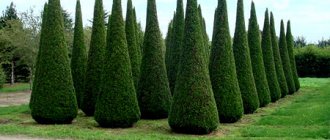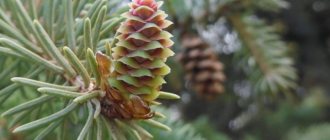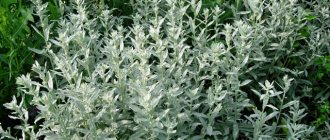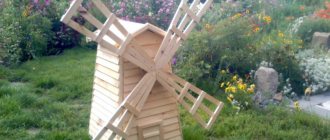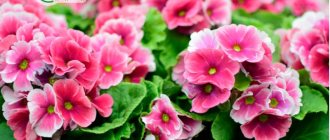Sage – an ornamental herbaceous plant of the Lamiaceae family. This family includes medicinal plants used in perfumery, cooking and medicine. Name " sage", or "salvia", comes from the Latin word "salus" (in transcription - [salvus]). It means “grace”, “health”, “salvation”. Image sage often used on medicine packaging. It has become a kind of symbol of medicinal plants in pharmaceuticals. Sage It amazes with its variety of shapes and colors, among which you can find both ordinary and absolutely amazing ones.
Reference! According to various sources, there are up to 700 species of sage in the world.
Varieties
In nature, there are a large number of varieties of this plant.
The most popular and famous are:
- Medicinal, which reaches 70 cm in height and has a gray-green color. There are several subspecies: Breeze , Aibolit , Nectar and Semko Patriarchal .
- Forest or wild. It is distinguished by its small height and the presence of purple, blue or violet flowers.
- Lugovoy has a yellowish color. The inflorescences are small, but there are a lot of them.
Most often, medicinal and meadow sage are grown in garden plots. But sometimes you come across a forest one.
It is worth considering the most popular varieties that are excellent for planting in a summer cottage.
| Variety | Short description |
| Guarani | The buds are blue, with almost black calyxes, a perennial plant. The height reaches 1.5 meters, and the width of the bush is about 60 cm. |
| Dubravny | The flower grows up to 1 meter and is about 60 cm wide. The flowers can be white, purple or violet. |
| Adhesive | Yellow buds, flower height up to 90 cm with a width of about 50 cm. Likes to be in partial shade, requires moister soil compared to other varieties. |
| lavender leaf | Externally very similar to lavender. It can grow in regions where the air temperature does not drop below -23 degrees. |
| small-leaved | This is an evergreen subshrub that reaches a height of 120 cm. It comes from Mexico and blooms until the end of summer. Requires special care, as it dies at -5 degrees. |
| Fire red | Bright red petals. The flower is up to 30 cm wide and about 70 cm high. It is from South Africa. |
It is possible to use several varieties at once to create an original composition on the site.
Description of the plant
Sage (Salvia officinalis L.) is a species of perennial plant of the Lamiaceae family. Originates from the Mediterranean region (Albania, Yugoslavia, Greece, Italy), where it usually grows wild in the hills. Often found outside this area. Cultivated in many countries of the world.
The Latin name for sage comes from the Latin salvus, meaning health. It has long been considered a medicine; in ancient times it was a symbol of health and longevity.
The plant reaches a height of 50-70 cm and tends to creep. The flowering period of sage occurs in May-June. Grows on sunny slopes and rocks, in relatively moist soils rich in calcium.
Table. Morphology of sage
| Stem | Straight, tetrahedral or round, woody below, branched. The entire plant is slightly pubescent. |
| Leaves | Green-silver, soft to the touch, the lower ones are long-petiolate, the upper ones are sessile, longitudinally oval or lanceolate, located opposite each other, wrinkled on top. The edge is slightly jagged. |
| Flowers | The inflorescences are two-lipped, violet-blue, collected in 4-8 whorls. |
Varieties with decorative leaves are especially valued:
- “Purple” (Purpurascens) - with purple leaves and shoots, decorative, compact inflorescences with pink flowers;
- "Argenteovariegata" - with gray-green leaves with lighter yellowish, uneven coloring along the edges;
- "Icterina" - with light green leaves with lighter yellowish, irregular coloring along the edges;
- "Aurea" (Aurea) - with yellowish-green leaves with a yellowish-gold color along the edges;
- "Tricolor" - with purple shoots, dark green leaves with white jagged edges and the youngest leaves at the tops of the shoots are pinkish.
Photo. Varieties “Tricolor” (left), “Gold Blue” (right).
Growing and care
Different varieties of this plant require special care. Thus, the meadow prefers to be on the sunny side and requires moderate watering, while the forest needs more shade and abundant watering.
Despite the diversity, there are several common requirements:
- on sandy loam soil the plant feels better;
- It is recommended to use humus as a fertilizer;
- in winter you need to cover;
- In the spring, pruning is required.
Salvia is considered a heat-loving plant. Therefore, in the northern regions it is grown as an annual plant. They are rarely replanted in the ground again.
Useful information from gardeners
Carefully choose a place to plant sage and it will delight you with its flowering for up to 8 years.
Before planting, you need to resolve several important issues. This determines how long the salvia will grow. She can stay in one place for up to eight years.
Selecting a location
You need to choose the sunny side, where the soil is light. Even on rocky or sandy soil, sage will do well. But in the presence of clay, it will not be able to grow normally.
Sage is usually unpretentious. Therefore, it is enough to provide a good drainage system so that it can grow without additional care. But it is recommended not to forget about the flower. With proper care, the buds will be brighter and more beautiful.
It is necessary that the roots do not suffer from lack of air and excess moisture. Otherwise, they will begin to rot and the plant itself will die.
Plant sage in a place where there is more sun, then it will be able to reveal all its beauty
Lighting requirement
Planting in the shade will not kill the plant. However, it will not allow him to reveal all his beauty. Therefore, it is recommended to choose southern areas where there is no shade. The rate of development of sage directly depends on the air temperature outside and sufficient lighting.
If the flower is in a pot, it needs to be provided with maximum peace. It is not recommended to move it and replant it again. All this causes stress, which affects the rate of growth and flowering.
Additional Information
Planting a plant will be successful if you remember a few important nuances:
- sage tolerates drought well;
- the plant does not survive at low temperatures;
- a lot of space is needed, since the flower does not have a highly developed root system, so regular weeding is required;
- for rapid growth and strong flowering, it is necessary to use fertilizers;
- the distance between bushes should not be less than 30 cm.
If potatoes, cabbage or legumes grew in this place before the sage, then there should be no problems with the necessary minerals. It is possible to do without feeding for the first time. However, to obtain the desired effect quickly, it is recommended to use organic fertilizers.
Preparing the right soil
Sage needs soil with normal acidity, that is, 5.5-6.5, in addition, it should be light and preferably loamy. In the fall, before digging, do not forget to add compost or humus. We dig diligently.
You can also feed with potassium-phosphorus fertilizers. If the soil is clayey, add some sand to it.
In addition, it is better to choose places where there is a lot of light. Sage also loves moisture. In our latitudes, it is best to grow, for example, Ethiopian sage. Mediterranean varieties of sage can also be grown, but only as annuals.
Landing rules
Sage seeds
Usually seeds are used for planting. They can be planted directly in open ground or first in pots (in spring), and then transplanted into the ground. It is necessary to understand that when planting seedlings, the plant is in greenhouse conditions.
That is, it gains altitude quite quickly. However, any manipulation causes stress in the flower. Therefore, you need to be prepared for the death of some seedlings during transplantation into open ground.
If seeds are used immediately, then everything must be done as follows:
- the soil must first be prepared by adding organic fertilizers (humus is best);
- seeds are planted 3 mm deep at a distance of 30 cm from each other;
- For the first 15 to 20 days after planting, the soil should always be moist.
After the emergence of seedlings, it is necessary to switch to watering 1 – 2 times a week. However, at the active growing season, the plant will again need to be systematically irrigated. Mature flowers are watered only when the soil dries out.
Obtaining seedlings
Since it is easiest to grow sage from seeds in central Russia using seedlings, the gardener’s main efforts should be focused on this work.
It is advisable to start working with planting material in February-March. You can read below about how to grow sage from seeds by direct planting in the ground.
Seeds should be soaked in warm water for a day before planting. Then rinse the bag in a pink solution of potassium permanganate to disinfect. Seeds prepared in this way can be sown in a seedling box, planting them to a depth of no more than 1.5 mm. Cover the box with glass or film and place in a warm place (20-25 degrees Celsius). Ventilate periodically, opening for 5-20 minutes to further check the humidity and absence of mold.
In two to three weeks, sprouts will appear. The glass must be removed and the box placed in a lighted room. The best place is next to the radiator, under the windowsill. The temperature for sage should not be below 20 degrees Celsius - the plant is heat-loving.
Seedlings about 1.5-2 cm high should be transplanted into cups (peat or paper pots), remembering that the root system of sage is powerful, so it is easily damaged when planted in the ground, if removed from plastic containers.
Features of care
Don't forget to care for salvia
Salvia does not require specific care. However, certain actions need to be performed periodically to make the plant bloom better. So, in the second year it is important to prune. Old shoots are completely removed at a height of 10 cm from the soil. They can be used in a compost pit to make humus. It is best to prune in the fall.
In spring, it is recommended to add nitrogen-containing fertilizers to the soil. They will speed up growth. After pruning, the plant should add phosphorus and potassium. There are many different fertilizers on the market. They must be added according to the instructions.
Expert opinion
Chernyaeva Tatyana Dmitrievna
Absolutely loves gardening and grows only organic vegetables
Ask a Question
Excess nitrogen can burn the roots of the flower, so do not use this mineral too often.
Sage collection
In the first year, it is not advisable to pick leaves, especially if there is no need. Collection is carried out starting from the second year of the plant’s life, and can continue throughout the year. The most favorable time for harvesting medicinal raw materials is before flowering begins. During this period, the concentration of nutrients in the plant is maximum.
The last harvest for the season is made no later than two months before the first frost. This is necessary so that the plant has time to recover before the onset of winter.
sage in a well-ventilated area or outside. In the latter case, the grass is protected from rain and direct sunlight by a canopy. Dried leaves and branches are stored crushed in glass or paper containers.
Tips from experienced gardeners
There are several important nuances that can make the process of growing sage in a summer cottage easier:
Have you already planted sage in your garden?
Yes in plans!
- watering should be regular only for the first couple of weeks, and then it should be done as needed;
- in the spring it is advisable to add fertilizers for faster growth;
- it is necessary to remove weeds in a timely manner, otherwise the flower will die;
- if you grow sage near other crops that are exposed to parasites, they are likely to go away;
- plants cut in the fall should be put into a compost pit in order to fertilize the soil with the resulting humus in the spring;
- the top and flowers can be used for medicinal purposes, but shoots from annual trees are collected only in early autumn.
Do not use large amounts of fertilizers. The flower is unpretentious, and they are required only to enhance flowering. Excess nitrogen in the soil, which is found in all organic matter, can damage the root system of the flower.
Wintering
There are two ways to ensure wintering of sage:
- In the southern regions of Russia it is possible to leave roots in the ground. But it is necessary to cover the cut flower with film or a bottle. This method of ensuring safety is relevant if the air temperature does not drop below -10.
- In the rest of the country, the root is dug up. It must be washed and the remaining soil removed. You also need to prepare a box in which the flower will be stored. It is recommended to use sawdust or mulch to ensure preservation.
Expert opinion
Chernyaeva Tatyana Dmitrievna
Absolutely loves gardening and grows only organic vegetables
Ask a Question
It is important that when storing the flower, a constant temperature (5 - 7 degrees) and air humidity are ensured. It is necessary to check the condition of the roots once a month. If necessary, they should be irrigated with a spray bottle.
Reproduction methods
There are several ways to propagate this plant, namely:
- Seeds . When flowering ends, the flowers fall to the ground. It is in them that the seeds ripen. They need to be collected, treated against possible pests and dried. Until spring, they need to be kept in a paper bag, which will allow air access. During the planting period, it is necessary to prepare the soil.
- Division is important if the sage takes root well. To do this, you need to divide a bush that is more than two years old into 2–3 parts. it is important not to damage the root system. After division, you need to transplant the flower to the required place.
- By cuttings . To do this, you should take a woody shoot and put it in water. When it gives roots, it can be planted in the ground. It is necessary that the cuttings be 12–16 cm.
Natural reproduction occurs precisely by seeds. You can assemble them yourself or purchase them in a store. However, store-bought seeds are often modified in such a way that it is impossible to breed new ones from them.
Read the article on the topic: Spinach: growing and caring in open ground
Use as folk remedies
Sage is an effective healer, and these qualities are used to make folk remedies:
- Against cough. Several branches are infused in a glass of boiling water and the drug is taken 2 tbsp. l.
- For mouth rinsing to fight infections. Several branches are boiled for 15 minutes. in water. Then the solution is filtered and boiling water is added to the original norm. Rinse 7 times a day, every 4 hours.
- For the intestines. 3 branches are infused in 250 ml of water. In 20 min. Before meals, the drug is taken ¼ of a glass 3 times a day. Reception is carried out throughout the week.
It should be remembered that long-term use is unacceptable. The drug tends to accumulate in the body, which leads to negative consequences.
Read about the plant: perennial ryegrass.
Diseases
Sage is a medicinal plant and is therefore considered an excellent insecticide. However, it is susceptible to some diseases.
Therefore, you need to take certain actions to save the flower after detecting signs of disease.
1- Root rot 2- Rust
| Disease | Short description |
| Rust | Dense brown teliosoruses appear on the underside of the leaf. The leaves begin to turn yellow and fall off. It is necessary to remove the affected areas so that the flower does not die. |
| Black root rot | The roots become covered with plaque and gradually turn brown. If the damage is severe, the plant dies. Fungicides must be used to control the fungus. |
| Root rot | The lower part of the stem darkens, rot and plaque gradually appear. It is possible to combat this disease with fungicide solutions. |
Interestingly, parasites rarely infect sage. If for some reason they decide to feast on it, then they will leave after a while. You don't have to do anything special.
Thus, sage is an excellent perennial plant that can delight with its inflorescences for up to 8 years in the southern regions. In other regions of the country, it is used for no more than two years, after which a new one is planted. It is possible to plant it as seedlings, but it is better to immediately plant it in open ground. With proper care, sage will produce large and beautiful buds that will bloom for quite a long time.
Photo gallery
_kateleen_
klumba.irk
uliasav4uk
art55full
travi_chai_ua
zdravia_vsem


